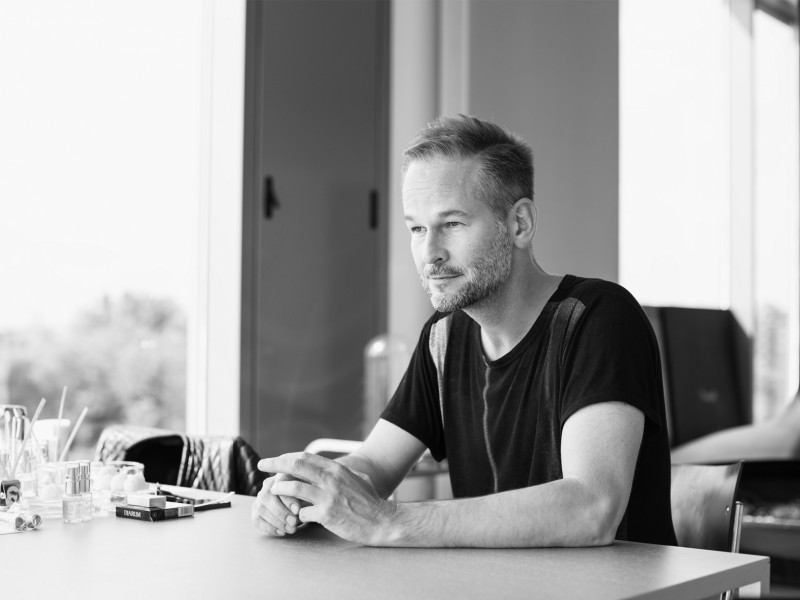Contemporaneously art and fashion are economic and cultural bedfellows, but it wasn’t always so. Historically art and fashion found themselves philosophically opposed. Within each discipline there traditionally existed a hierarchy of value. Fashion was understood to be fickle, transient and in constant flux, and art was considered intellectual, even elitist. Art aspires to a cultural longevity that fashion, by its very nature seems designed to negate. Its natural condition is to usurp itself, to render redundant that which has come before.
There were early 20th century art and fashion luminaries who were viewed as cultural rebels for their collusions. Artist Sonia Delaunay transposed her exquisite abstractions to fabric, while fashion designer Elsa Schiaparelli, collaborated with artists such as Jean Cocteau and Salvador Dalí with whom she created the lobster dress, infamously worn by Wallis Simpson. In the 21st century many of the traditional cultural hierarchies that existed have all but collapsed. Art well and truly exists as part of a market economy alongside fashion. In the new millennium, art and fashion’s dalliance, as compared to Delaunay’s colour and fabric experiments or Schiaparelli’s pre-punk gestures, has serious mainstream economic and cultural repercussions.
Yves Saint Laurent appropriated Piet Mondrian in the 1960s with six dresses that paid homage to modernity and the new universal spirit of feminism. Inspired by the De Stijl movement, they articulated a vision for the collection that was significantly pared down. The A-line silhouettes gave the dresses a minimalist aesthetic further enhancing their modern appeal. For Saint Laurent, Mondrian’s paintings embodied an artistic purity that had been missing from fashion.
Fast forward to the new époque and the list of luxury brands that have collaborated with artists is prolific. During Marc Jacobs’ tenure as creative director at Louis Vuitton, he engaged with artists such as Takashi Murakami, Jake and Dinos Chapman, Richard Prince and Yayoi Kusama. Through his collaborations with artists, Jacobs inspired new and existing clients to embrace contemporary art and with it contemporary fashion.
Designer Raf Simons has most notably displayed his interest in collaborating with art world luminaries, including the legendary photographer Robert Mapplethorpe and contemporary artist Sterling Ruby. In 2012 for his debut collection at Dior, Simons collaborated with Ruby by using the rich and abundant textures of the artist’s prints on the fabric of his silhouettes. Known for his minimalist masculine designs, Simons utilised the bright and detailed prints to reveal his dynamic feminine aesthetic, which impressed the fashion industry and bolstered his reputation as a visionary haute couture designer. After Simons left Dior he revisited Ruby for another collaboration for his eponymous label. This time he elevated the collaborative quotient by having Ruby paint and dye the actual fabric in his own studio in Los Angeles. Simons’ collaboration with The Mapplethorpe Foundation for his Spring/Summer 2017 release blurred the lines of art and fashion, with Simons once again applying direct photographic prints onto the fabric of each piece in the collection.
The late Alexander McQueen turned to artists for his runway inspiration, as well as posthumously for a collaboration with Damien Hirst. Hirst came to prominence as one of the Young British Artists, an enfant terrible infamous for his use of dead animals and meditations on life and death. His concerns were well suited to McQueen, whose own creative preoccupations resulted in collections steeped in Gothic darkness. The butterfly paintings and the scarves upon which they are based operate as a momento mori of sorts.
Collaborations have influenced some of the most iconic collections and in some cases have reoriented and reinvigorated many global brands. A case in point is artist Cindy Sherman, who appeared in a series of advertisements for Comme des Garçons in 1993. Sherman’s artistic project involved an ongoing series of self-portraits that pushed the mainstream boundaries of what was considered beautiful at the time. It complimented the ethos of the Japanese label, who consistently strived to challenge conventional ideas of beauty and body image.
By aligning with artists, fashion has acquired an extended and more nuanced intellectual framework. Artistic collaboration has and can turn patrons into art collectors, or a t-shirt into a collectable. To say that art is imbuing fashion with deeper cultural references while fashion is attracting new crowds to art would be understating the profound cultural effect that the union has produced. Perhaps equally fascinating is how the ripples have created a new and idiosyncratic generation of cultivators and consumers alike.
Related Features
-
182
-
-
-

